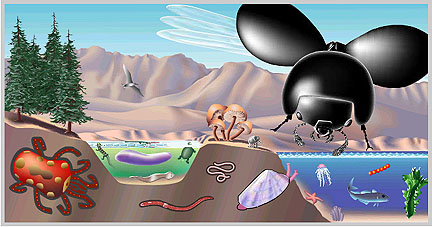
Source of Image: Cornell Virtual University Species-Scape Illustration of Major Groups Scaled by Diversity
Notes for Chapter 20:
Terrestrial Mandibulates (Myriapods
and Insects)
Click link to return to Lecture
Schedule
or back to Chapter 19
or ahead to Chapter 23 (under construction)
Chapter 20 Assignment: 411-427, 432-437; RQ-20: 1-4, 6, 7, 9, 10, 18
Introduction: A Winning Combination

Source
of Image: Cornell Virtual University Species-Scape Illustration of Major Groups
Scaled by Diversity
Featured organism: Beetles
Links: 1
- 2 - 3
- 4 - 5
- 6
- 7
- 8
- 9 - 10
- 11 - 12
- 13 - 14
I. Chilopoda (Centipedes)
1 pair of antennae and uniramous appendages (like millipedes and insects)
dorsoventrally flattened somites
somites - 1 pair of jointed legs
first somite - maxillipeds , poison fangs
malpighian tubules (excretion)
trachea (respiration)
predators, generally in dark moist habitats
II. Diplopoda (Millipedes)
cylindrical bodies
somites - two pairs of jointed legs per "somite" (segment)
appears this way because pairs of somites have secondarily fused so two "segments" appear as one; actually only have one pair of jointed legs per segment)
lack fangs
malpighian tubules and trachea
herbivores, generally in dark moist habitats
possess repugnatorial glands (can squirt toxic/repellent substances)
III. Paurapoda (not emphasized)
IV. Symphyla (not emphasized)
V. Insecta (the insects)
Technically, a subgroup of Hexapoda, which
also includes collembolans
Insects are most speciose group of animals
Study of insects: ENTOMOLOGY
Three pairs of legs and wings (sometimes)
Live everywhere, do everything (but few marine species)
Tagmata:
head (1 pr antennae + mouth parts)
thorax (3 pr legs), abdomen
wings absent in a basal groups
Pterygota: clade of winged insects
(includes some, like fleas that have secondarily lost
their wings)
flight evolved only once in hexapods
likely first evolutionary step: surface skimming insects
structure:evaginations of the cuticle
supporting veins
trachael system
contain blood primitively
-wings were held outstretched
-wings became foldable in subcladefunction: alternate contractions of antagonistic elastic systems
feeding and stuff:
mouth parts-mandibles (1 pr)
maxillae (1 pr)
labium (fused 2nd maxillae)
primitively mouth parts used for chewing
piercing and sucking mouth parts are derived
gut modified to enhance water retention
(gut is chitinous fore and aft)respiration:
tracheal system
spiracles to body surfaceexcretion
uric acid via malpighian tubules
circulatory system
dorsal tubular heart and open circulatory system
nervous system
similar to annelids
sensory system
large, compound eyes
reproduction
sexes usually separate
metamorphosis
juveniles do not compete with adults for food
hemimetabolousgradual or incomplete: juvenile slowly becomes adult
holometabolous
complete: juvenile distinct from adult
sociality
division of labor among distinct morphotypes
best developed in two groups:
hymenopterans (ants, bees) and isopterans (termites)
Review:
which insect "orders" are most speciose?
what factors contribute to being speciose?
what common insect body parts do bristletails and springtails lack?
why are these missing?
contrast hemi- and holometabolous development
give some examples of each
who has internal wing pads as larvae?
which insects account for the most insect biomass?
what are the three body regions of an insect?
what structures are found on the head?
give some examples of different insect mouthparts
how are antennae used?
what paired structures are found on the thorax?
give examples of wing modification
what structures are found at the abdomen?
how do insects respire?
how do they control the openings to the outside?
what are malpighian tubules? sensilla?
how do insects sing? attract mates? exchange gametes?
what are instars? nymphs?
contrast brain, molting, and juvenile hormones
VI. Insects and Human Welfare (not emphasized)
VII. Classification of Insecta (p. 432-433)
Emphasize the following orders:
holometabolous: beetles (Coleoptera), flies (Diptera), moths and butterflies (Lepidoptera), bees, ants, and wasps (Hymenoptera), fleas (as example of secondary loss of wings)
hemimetabolous: grasshoppers (Orthoptera), true bugs (Hemiptera), dragonflies (Odonota), mayflies (Ephemeroptera)
direct development (also primitively wingless): silverfish (Thysanura), and springtails (Collembola)
VIII. Phylogeny and Adaptive Radiation
More Links: (I seem to
have accidently deleted this section -- anyone have a backup?)
Click link to return to Lecture
Schedule
or back to Chapter 19
or ahead to Chapter 23
This page created 10/14/01 © D.J. Eernisse, Last Modified 10/19/01, Links Last Completely Checked 10/14/01